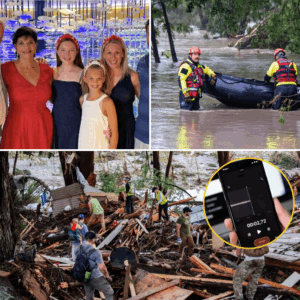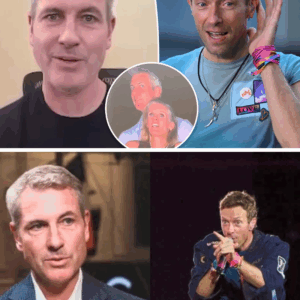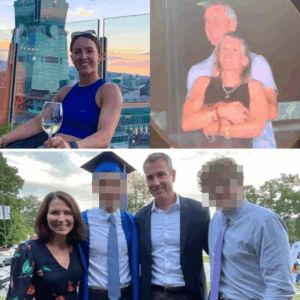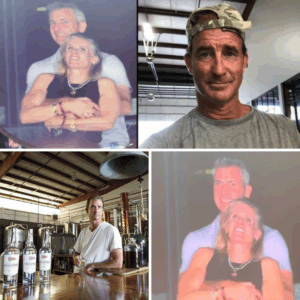A Beacon of Hope Amid Tragedy
In the early hours of July 4, 2025, the small town of Hunt, Texas, was engulfed by a catastrophic flood that would leave an indelible mark on the community. The Guadalupe River, swollen by torrential rains, surged beyond its banks, transforming quiet neighborhoods into raging torrents. Among the countless stories of loss and survival that emerged from this disaster, one tale stands out as a heartwarming beacon of hope: the miraculous survival of a family’s beloved dog, a blue heeler, who found refuge in the most unlikely of places—a washing machine. This extraordinary story of resilience and reunion, centered around high school senior Cody Vlasek and his family, captures the enduring bond between humans and their pets, even in the face of unimaginable adversity.
The Night the Flood Came
The Vlasek family, residents of Hunt in Kerr County, Texas, had lived in their home for nearly two decades. Their house, situated almost 30 feet beyond the designated 100-year floodplain, was considered safe from the whims of the Guadalupe River. But on the night of July 4, 2025, nature defied expectations. Heavy rains began to fall, relentless and unforgiving, turning the river into a destructive force. Within just 20 minutes, floodwaters had invaded the Vlasek home, rising to waist height and forcing the family to make a split-second decision to flee for their lives.
Cody Vlasek, an 18-year-old senior at Ingram Tom Moore High School, vividly recalls the chaos of that night. His mother, Denise, was the first to notice the rising waters, awakened by the sound of pounding rain. As the family scrambled to escape, the powerful current nearly knocked them off their feet. “The current—it almost tripped some of us,” Cody later recounted in an interview with KENS 5, a San Antonio news outlet. Amid the panic, the family’s blue heeler, a loyal companion, ran off into the darkness. With no time to search for their pet, the Vlaseks were forced to prioritize their own safety, making their way uphill to a neighbor’s house on higher ground.
The decision to leave their dog behind weighed heavily on the family. As they reached safety, they could hear the desperate cries of neighbors calling for help, a haunting reminder of the flood’s ferocity. “It was a horrible feeling because you wanted to help them, and you didn’t know what happened to them,” Cody told KENS 5. “But you knew, deep down, if you tried going out there, something would happen to you as well.” The Vlaseks, like many others in Hunt, feared the worst—not only for their home but for their beloved pet, who they believed had been swept away by the floodwaters.
A Community Devastated
The floods that struck Central Texas on July 4, 2025, were among the deadliest in the state’s recent history. The Guadalupe River rose over 20 feet in a matter of hours, fueled by rainfall equivalent to months’ worth in a single night. The disaster claimed at least 120 lives, with over 150 people still unaccounted for, according to CNN reports. Among the victims were 27 campers and counselors from Camp Mystic, an all-girls Christian summer camp located along the river, and many others, including children, grandparents, and community members. The scale of the tragedy was staggering, with entire neighborhoods reduced to rubble and families left to mourn irreplaceable losses.
Kerr County, where Hunt is located, bore the brunt of the destruction. Homes were swept away, vehicles were tossed like toys, and debris littered the landscape. The Vlasek family’s home, once a place of comfort and memories, was no exception. Walls were torn apart, furniture was scattered, and the structure was left in ruins. For Cody, who had spent his entire childhood in that house, the loss was profound. Yet, amid the devastation, a small miracle was waiting to be discovered.
A Miraculous Discovery
Days after the floodwaters began to recede, Cody returned to the wreckage of his family’s home to assess the damage. The scene was heartbreaking: mud and debris covered what was once the living room, and the house was barely recognizable. To enter, Cody had to break a window, climbing through the shattered glass into what remained of his childhood home. As he navigated the destruction, a faint sound caught his attention—scratching, followed by a soft whimper. His heart raced as he followed the noise to the laundry room.
There, in a moment that seemed almost unbelievable, Cody found his blue heeler, trembling and soaked but very much alive, inside the family’s washing machine. The dog had somehow climbed into the drum, which had sealed enough to trap air and act as an impromptu life raft, keeping the heeler safe as the floodwaters raged. “I turned my head around the corner and saw him just floating in the washer,” Cody recalled, his voice filled with disbelief and relief. The sight of his dog, bobbing in the muddy water, was a silver lining in an otherwise grim reality.
The washing machine, an ordinary household appliance, had become an unlikely sanctuary. Experts speculate that the dog, in a moment of instinct, sought out the enclosed space to escape the rising waters. The sealed drum likely provided just enough air and protection to keep the heeler alive through the ordeal. For Cody and his family, the reunion was nothing short of miraculous—a rare moment of joy in the wake of a disaster that had taken so much.
The Power of the Human-Animal Bond
The story of the Vlasek family’s dog is more than just a tale of survival; it is a testament to the deep bond between humans and their pets. In times of crisis, pets often provide emotional anchors, offering comfort and hope when all else seems lost. For the Vlaseks, finding their blue heeler alive was a small victory that gave them the strength to face the daunting task of rebuilding their lives. “You can replace a house, but you can’t replace lives,” Cody reflected, acknowledging the loss of friends and neighbors while cherishing the reunion with his pet.
This sentiment is echoed by animal rescue organizations like Austin Pets Alive! and Kerrville Pets Alive!, which have been instrumental in reuniting pets with their owners in the aftermath of the floods. Volunteers have combed through debris, set traps for frightened cats, and established emergency veterinary clinics to treat injured animals. At Kerrville Pets Alive’s improvised clinic, veterinarian Dr. Mallory Cade examined dozens of survivors, including a soot-covered tabby named Rambo, who was reunited with his family after nearly a week missing. “We’re kind of the first responders for animals,” shelter co-founder Karen Guerriero told NPR, emphasizing the healing power of these reunions for families who have lost everything.
Austin Pets Alive! has taken in over 100 pets from shelters in Williamson and Kerr Counties, making room for animals displaced by the floods. The organization’s efforts extend beyond rescue, providing temporary fosters for pets like Superman, a dog found atop a pile of debris after losing his owner to the floodwaters. These stories of survival and reunion highlight the resilience of animals and the dedication of volunteers who work tirelessly to bring them back to their families.
A Community in Recovery
While the Vlasek family’s reunion with their dog offers a glimmer of hope, the broader impact of the July 4 floods remains devastating. The death toll, which includes teachers, campers, and grandparents, continues to rise, with recovery efforts shifting from rescue to the grim task of identifying victims. Among the losses were 27 individuals from Camp Mystic, including longtime owner and director Dick Eastland, who gave his life trying to save campers. The tragedy has left the community grappling with grief, even as stories of survival provide moments of light.
Country music artists like Miranda Lambert, through her MuttNation Foundation, have stepped up to support pet rescue efforts, raising nearly $18,000 for shelters and organizations in the affected areas. Lambert shared resources for donating food and volunteering, emphasizing the importance of helping both pets and their owners during this crisis. Other Texas artists, including Josh Abbott Band, Randy Rogers Band, and Robert Earl Keen, have also contributed to relief efforts, hosting benefit shows and donating proceeds to aid Kerr County’s recovery.
Lessons from the Flood
The Vlasek family’s story, along with others emerging from the Texas floods, underscores the unpredictability of natural disasters and the importance of preparedness. The fact that their home was outside the 100-year floodplain yet still succumbed to the floodwaters serves as a stark reminder that climate patterns are shifting, and areas once considered safe may no longer be. For pet owners, the story highlights the value of microchips and GPS collars, which have aided in other reunions, such as that of Ziva, a ranch dog found trapped in a flooded gully thanks to her Tractive GPS collar.
Cody Vlasek’s experience also speaks to the resilience of youth in the face of adversity. At just 18, he not only helped his family escape the flood but also returned to their destroyed home to face the wreckage and, ultimately, to find his dog. His actions reflect the courage and determination that have defined the community’s response to this tragedy.
Moving Forward
As Central Texas begins the long process of rebuilding, stories like that of the Vlasek family’s blue heeler offer a reminder of the small miracles that can emerge from even the darkest moments. The dog’s survival, tucked away in a washing machine, is a symbol of hope and perseverance, a reminder that life can endure in the most unexpected ways. For the Vlaseks, the reunion with their pet is a bittersweet victory, tempered by the loss of their home and the lives of friends and neighbors. Yet, it is also a source of strength, a reason to keep moving forward.
The broader effort to support flood victims continues, with organizations like Austin Pets Alive! and Kerrville Pets Alive! calling for donations and volunteers to aid in pet rescues and community recovery. For those looking to help, resources are available through local shelters and relief funds, as noted by NPR and other outlets. The road to recovery will be long, but the resilience of communities like Hunt, bolstered by stories of survival and reunion, will light the way.
In the words of Cody Vlasek, “You can replace a house, but you can’t replace lives.” The survival of his blue heeler, against all odds, is a poignant reminder of the irreplaceable value of life—human and animal alike—and the hope that persists even in the wake of disaster.





